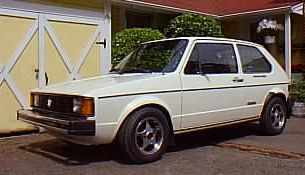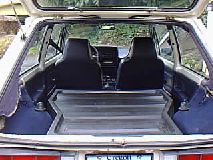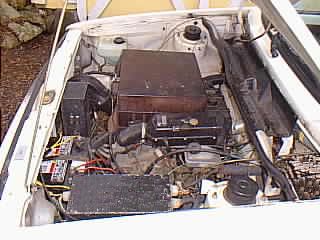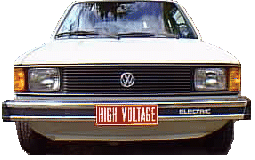1981 Rabbit EV
1981 VW Rabbit
 Manufacturer: SCT (South Coast Technologies) converted this new 1981 VW Rabbit L from a gasoline engine to electric power. The City of Portland, Oregon purchased the car to add to their fleet of alternative-powered vehicles, putting five thousand miles on the car in two years before selling it to my friend Mark. He drove it about another 700 miles, and then parked it in his garage, where it sat for the next 15 years, waiting for the 'right owner' to come along. This car has only 22,000 original miles as of today. Original selling price of the car was $16,550.
Manufacturer: SCT (South Coast Technologies) converted this new 1981 VW Rabbit L from a gasoline engine to electric power. The City of Portland, Oregon purchased the car to add to their fleet of alternative-powered vehicles, putting five thousand miles on the car in two years before selling it to my friend Mark. He drove it about another 700 miles, and then parked it in his garage, where it sat for the next 15 years, waiting for the 'right owner' to come along. This car has only 22,000 original miles as of today. Original selling price of the car was $16,550.
Motor: The electric motor is a Siemens 1GV1 shunt-wound DC traction motor, originally intended for use in an electric forklift. The rated output as installed in the car is 24 horsepower, which doesn't sound like a lot until you consider that electric motors, unlike engines, produce maximum torque at stall. The motor idles at 1650 RPM, which is full armature voltage of about 10 amps, and full field current. Motor speed is increased by weakening the field current, which makes the armature draw more current, up to 250 amps under load. A squirrel-cage blower directs air into the motor for cooling.
Batteries: Thirty eight Thundersky Lithium Iron Posphate (LiFePO4) cells in series are installed in place of the back seat and spare tire. System voltage is 120 volts DC nominal with 160 ampere-hours of storage capacity. These batteries weigh about 500 pounds, and are set into a 'well' welded between the frame members, very low in the body. This places the center of gravity of the car quite close to the road. The suspension has been modified to carry the extra weight, and the struts are competition units. As a result, this car corners as if it were mounted on rails. A removable fiberglass cover encloses the batteries, which are held down multiple heavy-duty ratchet web straps. These batteries bring the curb weight of the car up to 2,580 pounds.
Battery Management: Lithium chemistry cells require very careful monitoring of the charge and discharge voltage limits. This battery set is monitored and protected by a "MiniBMS" brand system. Each cell has a monitoring module, and upper and lower voltage limits are monitored to prevent over charging or over discharging. The MiniBMS project started as an open-source collaboration, but was eventually converted to a for-profit private company. The modules and head unit in my car is an early model.
Controller: Unlike EV's that use a series-wound motors, the speed controller is this car does not need to handle the full armature current of the motor (up to 400 amps in a series motor), but instead needs only to control the field coil current, which in this car is about 10 amps. This makes the job and circuitry of the controller much simpler. The factory-installed controller is a PWM (Pulse Width Modulation) circuit manufactured by EHV Systems, model EHV-1. Obviously, this was a proprietary controller, specifically designed and built for this car. It includes armature current limiting, motor over temperature protection and motor over current protection. Motor start up is provided with series resistors and contactors.
Regenerative Braking: Although shunt-wound motor configurations are less efficient than series-wound schemes, they do offer one advantage that most other motor types can accomplish only with extensive modification and complicated controller configurations, which is regenerative braking. During deceleration, this car can use the forward motion of the vehicle to produce a significant amount of charging current to the batteries, while providing well-controlled braking action. In effect, 15-25% of the battery capacity expended to bring the car up to speed can be recovered during a typical stop. In a conventional vehicle, this energy is dissipated as heat in the brake linings and drums/rotors. The braking action is enough to bring the car almost to a full stop from freeway speeds, even on downhill off ramps, by downshifting the transmission through each gear. It is usually necessary to use the brakes only in the last 20 feet or so to stop the car. Typical regenerative braking recharge currents are in the 100-200 amp range for a planned stop. Of course, in an emergency, one goes directly for the service brake to stop the car without downshifting. The currents from the regenerative braking extend the useful driving range of the car, while providing a surprising amount of stopping power.
Battery Charger: As shipped from the factory, this car had a 'Lestronic' battery charger, a huge, antique, transformer-based charger that weighed about 90 pounds. Mercifully, this charger had died and has been replaced with a Manzinita Micro PFC20 charger. The PFC20 is transformerless, weighs about 10 pounds (which is important in an EV!), and puts out 20 amps nominal. The charger has adjustable voltage and current settings, which allow for proper battery maintenance, and allows one to charge from standard 120 or 240 volt electrical outlets without changing settings. At home, I have a 30 amp service dedicated to the car, with a fused, manually-actuated disconnect. A dedicated kilowatt-hour meter is also installed to monitor the car's energy consumption. Currently, I am getting 4.5 miles/Kwh. At a cost of $0.075/Kwh, this is turning out to be cheaper than buying fossil fuel for the 4x4! I also carry an extension cord with the appropriate connectors to allow 'opportunity charging', in case I decide to fill up away from home. Commercial EVSE (Electric Vehicle Charging Equipment) is cropping up around my area, so topping up the charge while running errands is getting easier.
 DC-to-DC converter and 12 volt system battery: Although the motor runs on 120 volts, the rest of the car (headlights, wipers, horn, signals) operates on 12 volts. To power these loads, a Werker 100 ampere-hour gel cell auxiliary battery is mounted under the hood. This battery, in turn, is charged from the traction batteries by a 120 volt to 12 volt DC-to-DC converter when the car is running and when it is plugged in and charging. This converter is another proprietary device, capable of supplying up to 20 amps at 14.5 volts charging voltage.
DC-to-DC converter and 12 volt system battery: Although the motor runs on 120 volts, the rest of the car (headlights, wipers, horn, signals) operates on 12 volts. To power these loads, a Werker 100 ampere-hour gel cell auxiliary battery is mounted under the hood. This battery, in turn, is charged from the traction batteries by a 120 volt to 12 volt DC-to-DC converter when the car is running and when it is plugged in and charging. This converter is another proprietary device, capable of supplying up to 20 amps at 14.5 volts charging voltage.
Tires (and wheels): The original tires were old and beginning to separate and crack. Explorations into the internet revealed that most EV users put one type of tire on their cars for best mileage and range, Goodyear Invicta GLR's. These tires were developed in response to a request from Honda, which needed to recover a 4 MPG shortfall in gas mileage when they introduced the automatic transmission model of the Civic 1200. In an electric vehicle, range and mileage are purported to increase 25-30% with the use of these tires. My preliminary tests do show a mileage increase, but even more noticeable is that the car seems more willing to accelerate and has better top speed. Current draw is lower at any given speed, and the motor runs cooler as well. As Goodyear has discontinued production of the Invicta GLR series, I had to locate a set in Florida and have them UPS'ed here at additional cost. The stock wheel covers, while pleasing to look at, made a lot of noise, clicking caused by movement of the retainers on the wheels. I decided to go for broke and invest in a set of Eagle alloy wheels, which have made the appearance of the car more sporty, and are lighter in weight as well.
Instrumentation: All of the original VW instruments have been adapted to function on the electric conversion of this car. The engine temperature gauge reads motor temperature, the former fuel gauge is a state of charge indicator, and even the 'idiot lights' function as warning indicators of low charge and over temp. additionally, a dual range expanded-scale 260° sweep voltmeter and a +200 / 0 / -300 amp 260° sweep ammeter are mounted in the stock VW meter panel on the console, along with a Cruising Equipment Co. E-meter. I designed and constructed a 4" diameter, 1,600-4,800 RPM, expanded-scale tachometer, which is mounted up on the dash where I can easily see it.
Heater: (This isn't the tropics, ya know). Conventional internal-combustion vehicles use waste heat from the cooling system to heat the passenger compartment. As this car hasn't any waste heat to speak of, it's necessary to produce the heat from scratch. A factory-installed gasoline heater made by Bosch does an adequate job of the task. These heaters were installed on VW and Porsche air-cooled vehicles to supplement the feeble heat available from the engines. Although they are externally vented, a small amount of the combustion gasses find their way into the car, and as I am not fond of breathing Benzene, Tolulene, and who knows what other kinds of additives, I converted this heater to run on propane. Actually, the conversion process was simple, I disconnected the fuel inlet of the heater (forced-air furnace would be a better term), and connected it to the orifice of a salvaged gas barbecue jet. The gas metering orifice size must have been a lucky accident, as the heater fired up normally, roared it's happy little sound, and put out lots of clean, non-smelly heat. Total cost of conversion: $2.00 for the BBQ parts at the salvage yard. Currently, state-of-the art EV's use ceramic-core electric heaters which are adapted to take the place of the auto's original heater core. This may be an option for my car in the future, but for the time being the propane works just fine, and the price of conversion was right.
Modifications: Here's a link to a page of additional photographs and descriptions of modifications to the car and some information about the digital metering system it uses for instrumentation.
F.A.Q. Here are the most common questions to date:
Q: Is this really an electric car? A: No, I just didn't know how to spell "diesel".
Q: How far will it go between charges? A: It's supposed to go 35-40 miles, but the farthest I have needed to go so far is 28 miles.
Q: How long does it take to charge up? A: Depends on how far you drive it, overnight at most.
Q: How fast will it go? A: At least 65 MPH, cruises comfortably at 55.
Q: How long before you have to replace the batteries? A: A long, LONG time, I hope!
Q: What is the acceleration like? A: Unremarkable.
Q: What's the biggest problem with it? A: Forgetting to shift gears, it's quiet.

Projects: Like nearly everything else in my life, this car is a work-in-progress. I am in the middle of installing a thumpin' car stereo, and have just finished building a removable carpeted deck over the battery compartment so I can carry small cargo and tools. Finding and silencing the annoying squeaks and rattles is also a priority, as is upgrading to power assisted brakes. The headliner is in kind of ratty condition, and needs some attention. Of course, a smokin' custom paint job is highly desirable, but maybe in my next life as a wealthy eccentric.
Like I need another project, now I've begun construction on converting the Rabbit to run on fossil fuel. That's right! Convert your EV to Internal Combustion!!! Read all about it here: EV Pusher Project
Original material ©1996-2025 Mr. Sharkey | All rights reserved
